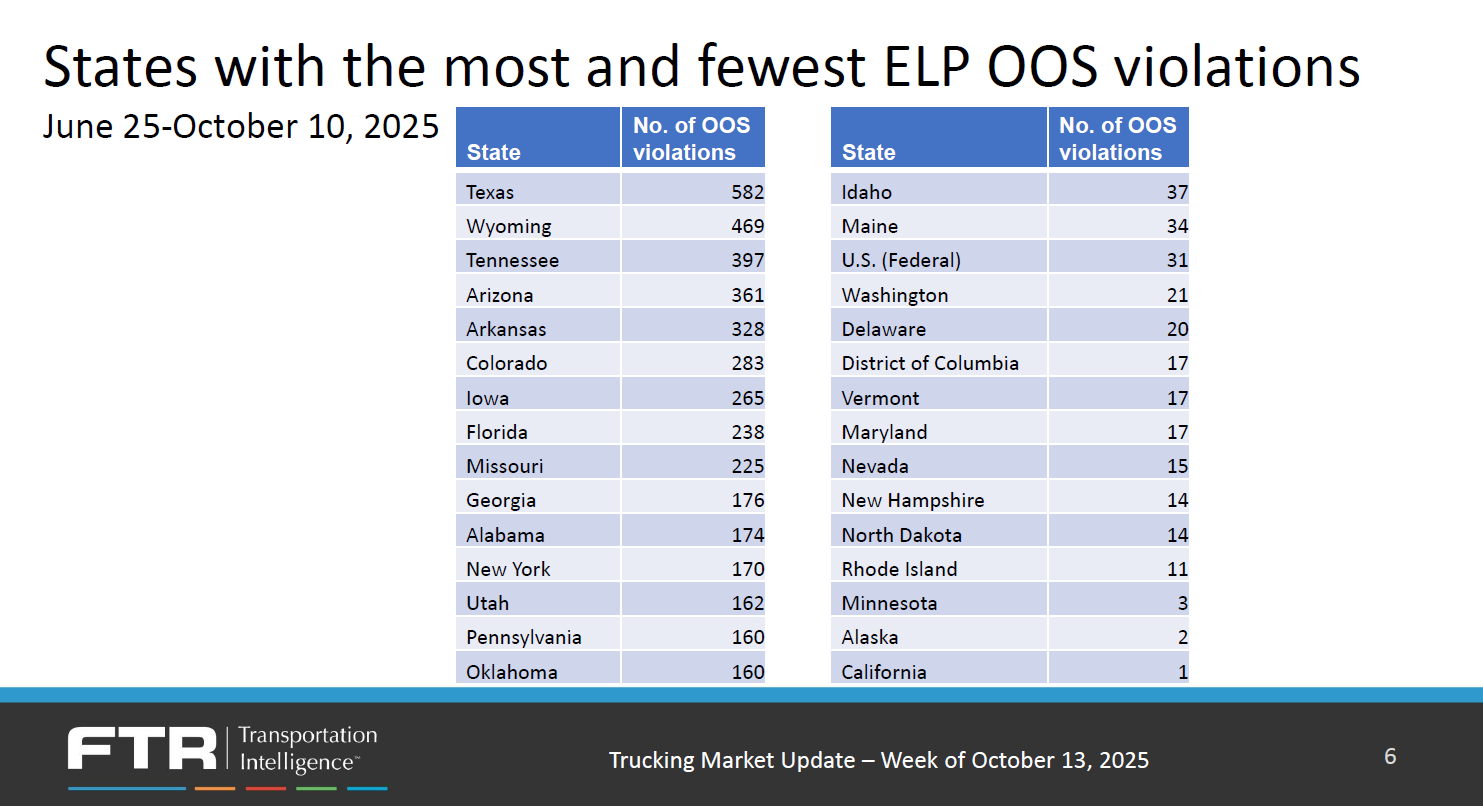
English Language Proficiency Enforcement Is Not Accelerating - Yet

When the Federal Motor Carrier Safety Administration (FMCSA) began enforcing English Language Proficiency (ELP) as an out-of-service (OOS) violation on June 25, 2025, the trucking industry took notice.
Four months later, it appears that enforcement is stabilizing at a level that will take thousands of drivers off the road but the impact is a fraction of that that will come from the severe restrictions imposed on non-domiciled commercial driver's licenses in late September. FMCSA estimates that that change could remove 194,000 drivers over two years — a development that could significantly tighten the truck freight market.
Many Violations, Far Fewer Sidelined Drivers
Since June 25, roadside inspectors have issued more than 23,000 English Language Proficiency violations, according to FTR’s analysis of FMCSA inspection data. However, fewer than 6,500 resulted in drivers being placed out of service — roughly 28% of all cases.

As we noted in our initial analysis of this topic nearly two months before heightened enforcement took effect, most violations occur along the U.S.–Mexico border, where FMCSA guidance specifies that drivers within the border commercial zone are not to be placed out of service. The result is that far fewer drivers are truly affected than the total number of violations would imply.
 25,000 Drivers A Year Potentially Forced Out
25,000 Drivers A Year Potentially Forced Out
By analyzing vehicle identification numbers (VINs) rather than driver IDs, FTR found roughly 16,200 unique trucks tied to ELP violations — and nearly 5,900 unique trucks placed out of service.
If we simply took the run rate since the beginning of heightened enforcement on June 25, that would result in around 20,000 drivers being forced out over the course of the first year. However, in the aftermath of a high-profile fatal crash in Florida in August involving an immigrant truck driver, the enforcement rate rose somewhat, in large part because Florida began enforcing ELP as an OOS violation in earnest. The state had not done so before August 22.
At the elevated rate of enforcement, FTR estimates that strict ELP enforcement could remove around 25,000 drivers from the road in the first year. While this sounds like a large number, it's a small fraction of the impact of the non-domiciled CDL restrictions and not enough to make a material difference in the market. Moreover, the data is not indicating any acceleration of enforcement, though we acknowledge this possibility of that happening.
Enforcement Patterns by State
The data reveal striking differences in enforcement rates across the country.
- Texas leads the nation with 582 OOS violations, followed by Wyoming (469), Tennessee (397), and Arizona (361).
- Florida, which initially did not issue OOS citations, became a major enforcer following the August 12 fatal crash that led Secretary of State Marco Rubio to freeze new commercial driver work visas. By mid-October, Florida ranked eighth nationwide in OOS violations.
- California, Minnesota, and Alaska, by contrast, reported almost no OOS activity. California issued just one violation despite FMCSA threats to revoke state safety enforcement funding.

For more insights like these, be sure to catch the FTR Trucking Market Update podcast each week, where we break down the latest trends shaping freight and driver capacity. 📊 Download the full podcast deck and listen to Episode 335 at ftrintel.com/trucking-podcast. And don't forget to subscribe to weekly updates!
Weekly Trends and Reporting Gaps
While weekly violation counts appeared to level off after summer, the decline likely reflects reporting lags rather than reduced enforcement. FTR notes that data completeness varies by state, so the official totals could still rise as additional weeks of data are finalized.

The Broader Impact
ELP enforcement is just one part of a broader federal focus on non-domiciled drivers and foreign-issued CDLs. Combined with stricter visa policies and licensing scrutiny, this could tighten the driver market further — right as freight demand remains unstable.
FTR analysts will continue monitoring ELP enforcement and related regulatory actions to understand how they’re reshaping carrier capacity and market dynamics.
Join industry leaders on November 4, 2025, in Houston for the FTR State of Freight: Chemicals & Petroleum Symposium—a one-day, deep-dive into how shifting trade, equipment markets, and economic forces are reshaping freight. Designed for shippers, carriers, and procurement professionals, this small-group forum blends expert forecasts with candid discussion to help you make smarter investment decisions.
Get the insights you need to make smart business decisions.
Together, Truckstop and FTR break down big data to deliver information you can use to maximize your profits.
- Weekly predictions and capacity
- Equipment and lane data
- Trusted names, trusted partners
Sign up for Spot Market Insights, the trucking industry’s weekly wellness report.
https://truckstop.com/product/spot-market-insights/
.png?width=1600&height=500&name=TMU%20blog%20October%2013%202025%20(1).png)
.jpg?width=1200&length=1200&name=2025%20FTR%20SOF%20Symposium_LI_1-1(1).jpg)


